Introduction
- When supporting the operation and logistics on healthcare provision and programs, numerous cyber appliances have been employed by many health administrations.
- These applications are similarly used as the chief component in the intervention of therapy and diagnosis and help retrieve and search data from knowledge bases.
- The cyber appliances in the health sector then again sustain correspondence amongst shareholders and service providers and as well support resources management.
- The information system has replaced what was regarded as the only jurisdiction of pen and paper work of the professionally skilled minds alone.
- An impressive advancement in the utilization and transmission of service info is apparent in the medicinal department particularly in the telemedicine classifications.
- The day to day performance of health information system is considered to be highly reliable and accurate.
- When supporting the operation and logistics on healthcare provision and programs, numerous cyber appliances have been employed by many health administrations.
- These applications are similarly used as the chief component in the intervention of therapy and diagnosis and help retrieve and search data from knowledge bases.
- The cyber appliances in the health sector then again sustain correspondence amongst shareholders and service providers and as well support resources management.
- The information system has replaced what was regarded as the only jurisdiction of pen and paper work of the professionally skilled minds alone.
- An impressive advancement in the utilization and transmission of service info is apparent in the medicinal department particularly in the telemedicine classifications.
- The day to day performance of health information system is considered to be highly reliable and accurate.
The information system has replaced what was regarded as the only jurisdiction of pen and paper work of the professionally skilled minds alone (Keyes, 2005).
The innovative computer science has extended and fashioned fresh connectivity amid information, systems, and enterprises of health services (Keyes, 2005).
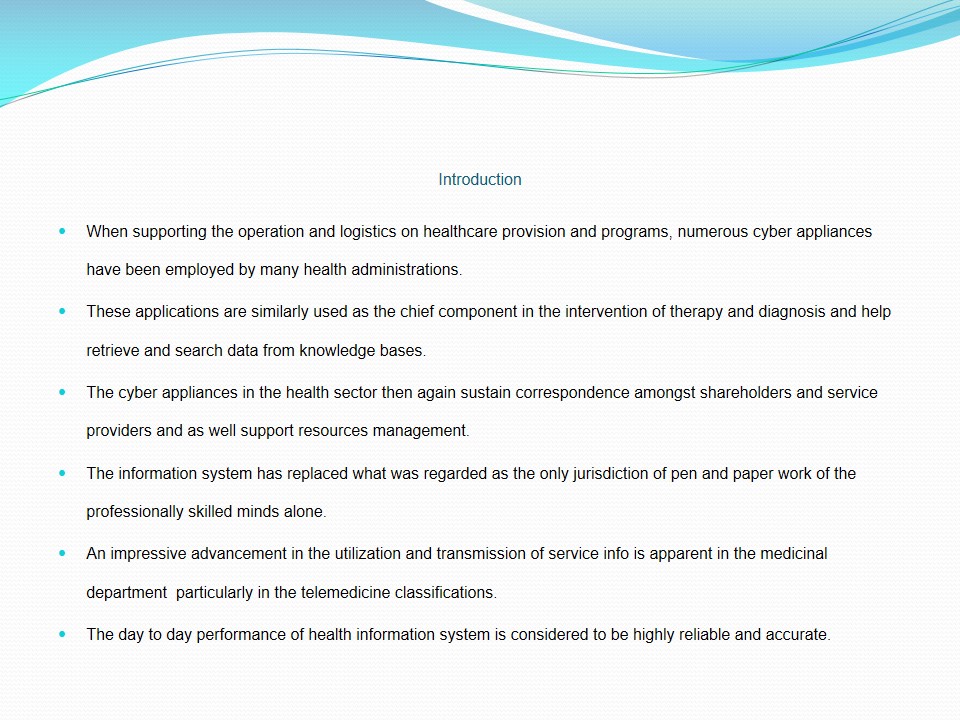

Cyber terrorism and healthcare information systems
- Numerous benefits have emerged from the use of internet in the sector of healthcare of various organizations.
- The use of internet has enabled the diffusion of all types of information as well as the expansion of communication all over the system of healthcare.
- The healthcare as a result has increasingly become dependent on activities carried out on the cyber.
- The probability of institutes or persons engaging in internet doings that causes damage psychologically or physically result from this dependency.
- The occurrence appears as cyber terrorism in healthcare systems and it accrues in the illuminating secluded public health records which allow hackers to bring down sanatorium computer system.
- The wide-ranging consequences of cyber terrorism are that, trust and reputation in the health system is weakened and the patients care is compromised regardless of form this crime takes.
- Any organization should be well equipped to deal with the incumbent upsurge in cyber threats in most health institutions.
- Threats are fluctuating constantly and as a result securing cyberspace does not turn out to be a stress-free proposition
- The extensive information technologist in the risk management policy department should be aware of cyber terrorism.
- Healthcare facilities or organizations can thus adopt and employ a number of best practices to protect them from the counter to cyber-attacks.
Any organization should be well equipped to deal with the incumbent upsurge in cyber threats in most health institutions (Leeuw & Bergstra, 2007).
Healthcare facilities or organizations can thus adopt and employ a number of best practices to protect them from the counter to cyber-attacks (Leeuw & Bergstra, 2007).
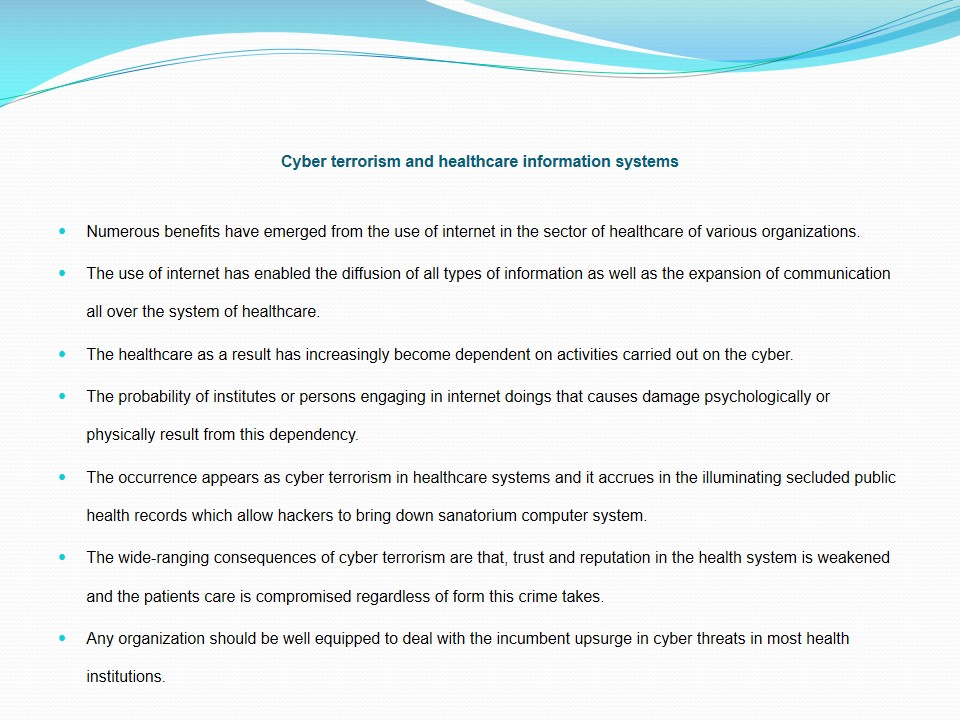

Cyber terrorism and healthcare information systems in the past
- Healthcare information such as financial data, and healthcare data transfer was of great importance to service providers.
- Other information including clinical data and patients’ information was important to those delivering or receiving the health services as opposed to anybody in the past.
- The organizations offering healthcare services had information reserved in administered documents and remained self-centered caregivers.
- Most healthcare information seemed to be safe but not very sufficient and could hardly be transmitted quickly.
- The healthcare amenities were thus boundless to the local operations and greatly classified inside administrative or clinical expanses.
- Atypical interests persist just in the viable or industrial significance, personal awareness, as well as negligence appellants.
- Complications in pulling together relevant data from diffused sources made access to health care info very limited.
- The circumstances of cyber terrorism were not rampant in healthcare in comparison to the present situation.
- The obliteration of conviction in health institutions, strategies, and frontrunners in addition to their misperception and unrest was caused by the emergence of cyber terrorism.
- The situation materialized with the change from paper work to the use of information technology, electronic networks, and information systems linking all health sectors.
- The dependence on information system and technology enabled various criminal institutions and criminals to illegally operate healthcare systems.
- These convicts and unlawful organizations to take advantage of unprotected information system to violate health institutions policies to achieve illegitimate purposes.
- However, cyber-terrorism never affected the past healthcare information system greatly but its emergence resulted into the present day cyber-terrorism.
Most healthcare information seemed to be safe and sound but not very sufficient and could hardly be transmitted quickly (Shapira, Hammond, & Cole, 1979).
These convicts and unlawful organizations to take advantage of unprotected information system to violate health institutions policies to achieve illegitimate purposes (Shapira, Hammond, & Cole, 1979).
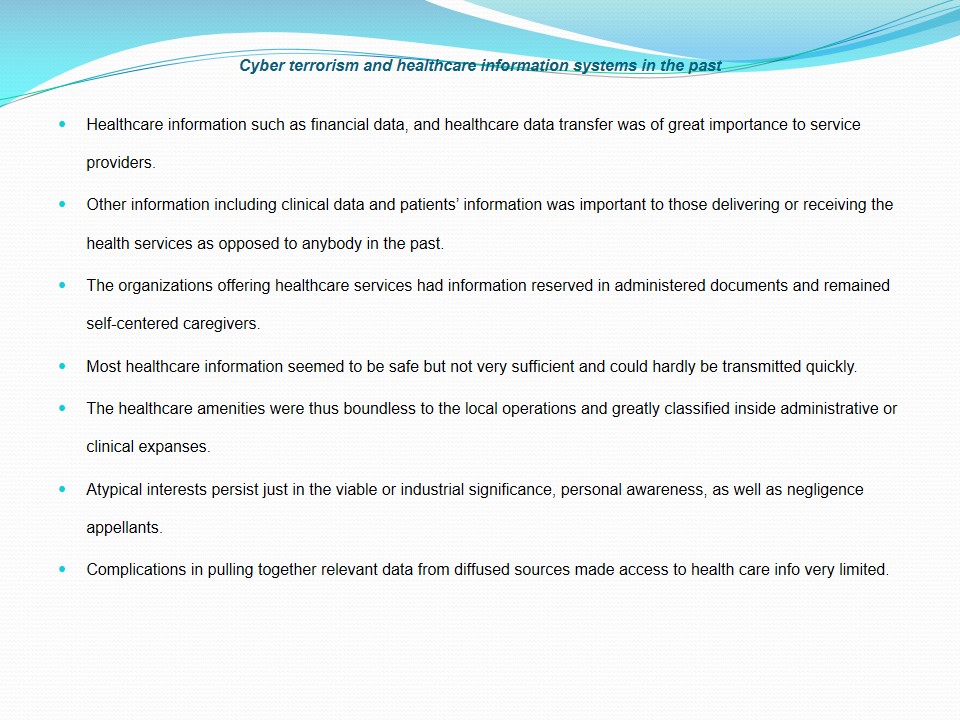
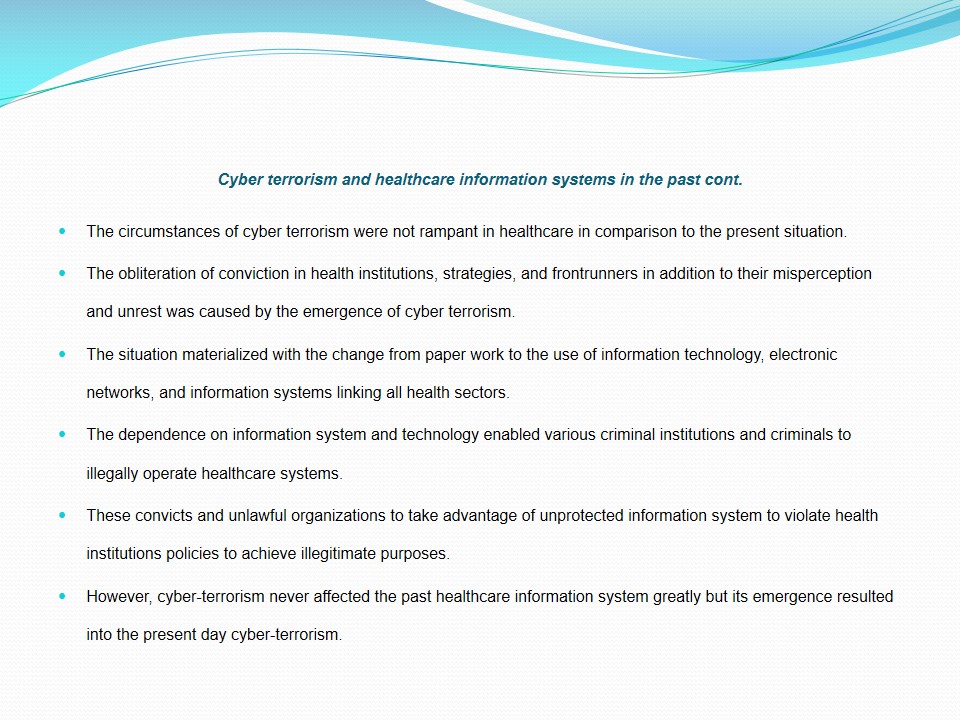
Cyber terrorism and healthcare information systems at present
- Healthcare facilities ought to be adequately prepared in the essence that cyber terrorism is currently on the verge.
- There is substantial dependency on the internet by most healthcare systems that use it to transmit information and for communication purposes.
- The emergence of cyber-terrorism intimidates the patients’ confidentiality and care besides imperiling their lives since e-healthcare services are prone to cyber terrorism.
- Healthcare organizations like hospitals have opted to the incorporation of tight networks from distinct workplaces hence enabling the risk to be further critical.
- The information machinery mainframe division namely the invoicing unit, radiologist, pharmacies, experimental labs, and admitting sections are regularly attached via such computerized set-ups.
- The managerial IT structures linking the out-patient and in-patient backgrounds appear to be attached to medicinal departments such as domestic, protracted term, as well as sensitive medical care.
- Cohorts in trade, insuring corporations, workforce, and the long suffering individuals relate and distribute info to new peripheral networks via such set ups.
- The internet and computer connections position healthcare facilities at a greater distress over the alteration of electronic health cover, pharmacy, and medicinal records due to cyber terrorism.
- The terrorists would most likely use the small invasion sequences that are problematic to cause major assaults if they were to hack the healthcare information technological system.
- Currently in the hospital networks, the terrorists introduce four distinct programs of malware to hack the system.
- Initially , such cyber attack campaign caused infection and demise, extended disorder, infected additional correlated info, corrupted therapeutic spell, the sick people’s accounts, and adjusted doctors schedules.
- The successive package sets off to restrain the moveable gadgets utilized by medicinal personnel in storing the info relating to sick people.
- Occasionally, cyber-terrorists uses software to deactivate alarms, adjust statistical exposition, and mug systems in the medicinal departments.
- Conversely, cyber terrorists employ software that reins the siphoning of remedies thus mixing different medicine prescriptions.
- After a few weeks later, the information technology support team gets disheartened completely as a result of such cyber terrorism.
- Thus, the entire hospital personnel misplace trust on every computerized data due to the quick alteration and different terrorists’ attacks on the system.
The organizational IT systems of outpatient and impatient settings are too connected to healthcare services ranging from home-based, long term, and acute care (Wolper, 2004).
The latter wave has impact on the software which gearshifts the pumps of drug infusion and the comparable devices (Wolper, 2010).
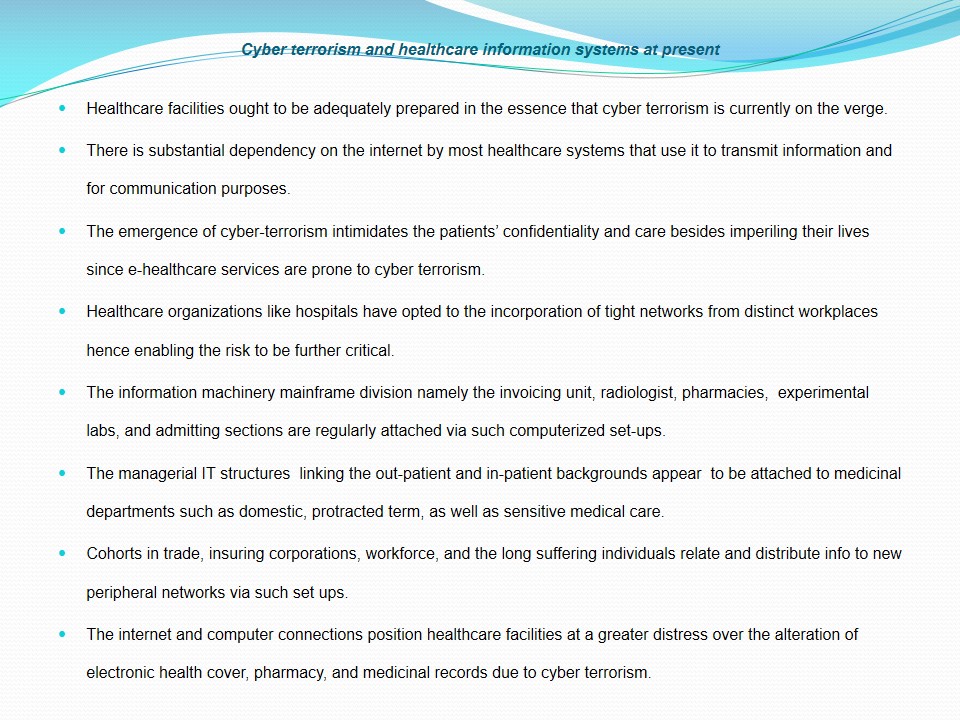
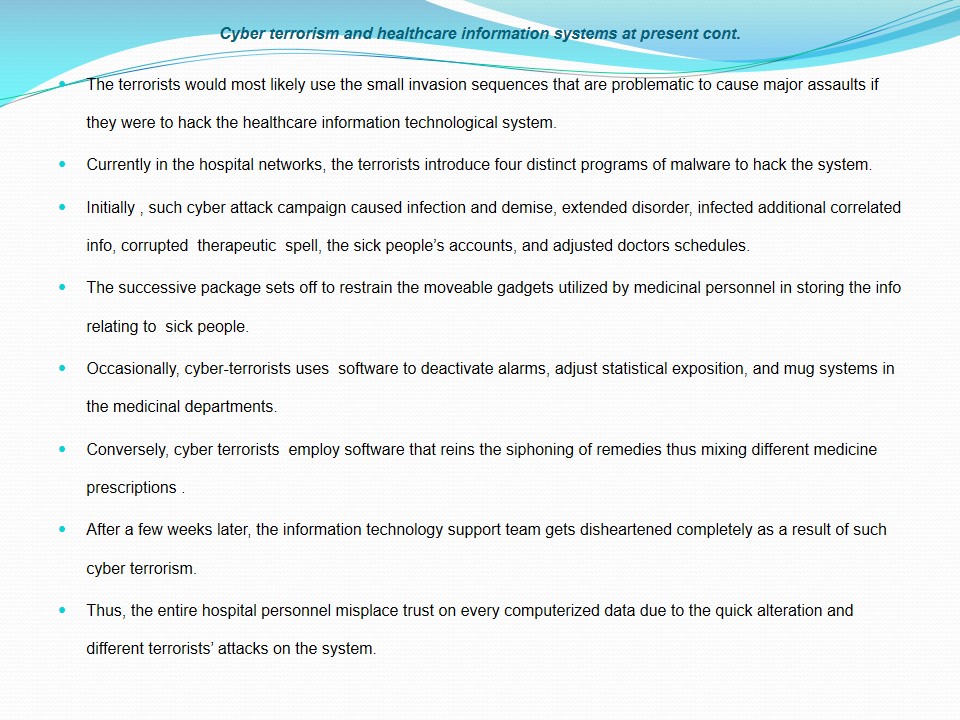
Cyber terrorism and healthcare information systems in future
- There is the possibility of reduced cyber terrorism in future thus health facilities will be able to offer vital apparatuses for home healthcare.
- The technical system will be reliable and available to make certain care in the battleground, rural health, diseases management and effective intensive care of remote patients.
- The trends result into formation of advanced e-health and telemedicine to cater for aeronautics and nautical setting, aided living amenities, and nursing homes.
- The functioning of e-healthcare as well as tele-care contribute considerably towards the provision of medicinal care.
- The future healthcare information system will promptly accommodate and employ measures to curb cyber terrorism.
- The information system and technology will cover full range of the health care applications and advances of telemedicine and administration of the electronic health records.
- The emergence of cyber attacks made health institutes to value the cause and upshots of tele-therapy based on admittance, rate and medicinal care value.
- E-Health and Telemedicine will offer an opportune attention to the progresses in technology.
- The evolution will sequentially proffer unsullied and novel infirmary, remedial midpoint, and grant health personnel with options on how to manage therapeutic statements, programmed accounts, and long-suffering care.
- The e-health and telemedicine will subsequently cover health service and biomedical research, health regulation and policy, and education.
- The innovative telemedicine and e-health will also consider technology enabling, medicinal connectivity, technical developments, and practices of telemedicine.
The information system and technology will cover full range of the health care applications and advances of telemedicine and administration of the electronic health records (Wolper, 2004).
The innovative telemedicine and e-health will also consider technology enabling, medicinal connectivity, technical developments, and practices of telemedicine (Wolper, 2010).
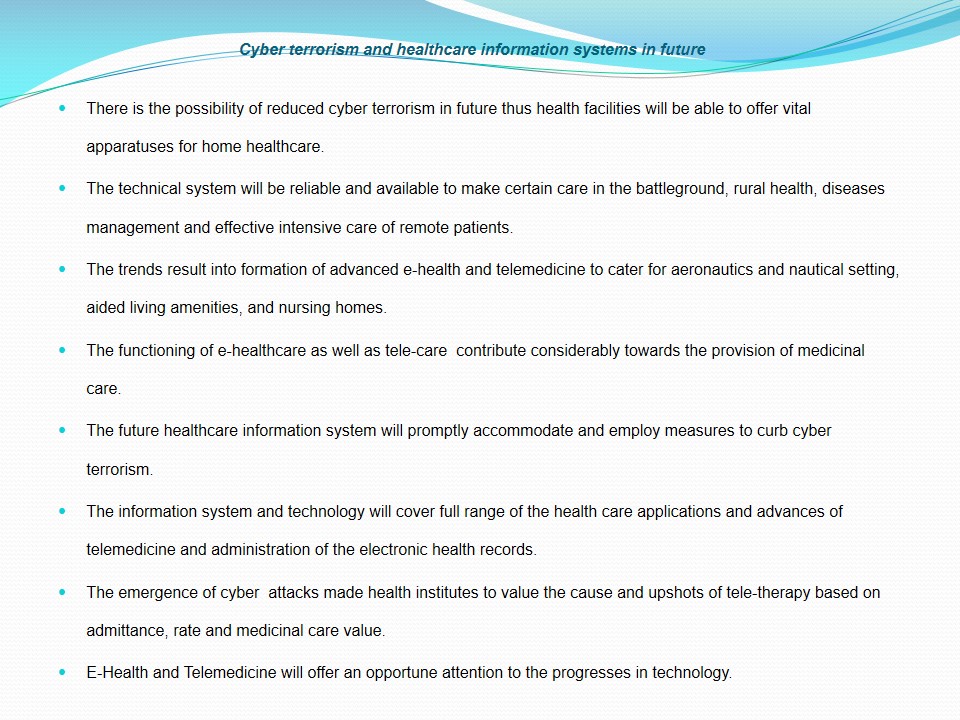
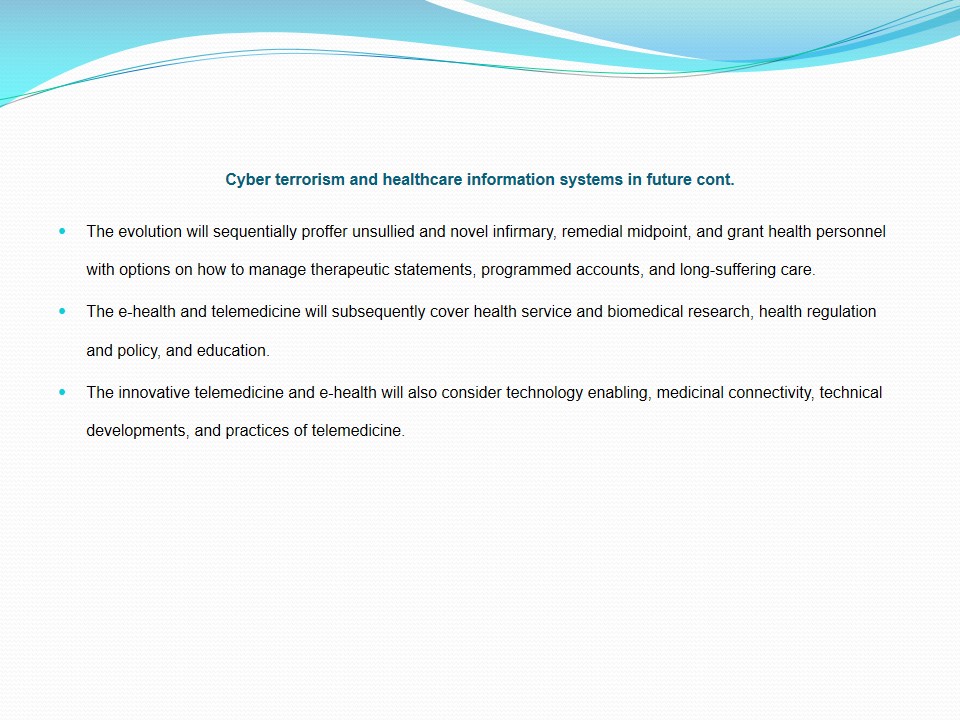
Conclusion
- There are remarkable efforts made in the fight of cyber terrorism since the initiation of internet usage on telemedicine.
- The information technology and system plus cyber terrorism are both significant in the field of health care.
- The issue of information security is the only concern when using telemedicine in healthcare sector as required by the health care systems.
- Almost twenty years subsequently to the invention, the web and internet remains an integral fragment in whatever we cover in entertainment, newscast, business and most importantly medication.
- Healthcare units must therefore remain watchful on cyber terrorism to safeguard the healthcare information system.
- Important also is to make sure we employ all the provisional measures put in place to curb cyber terrorism and maintain health information system in regard to healthcare services organizations.
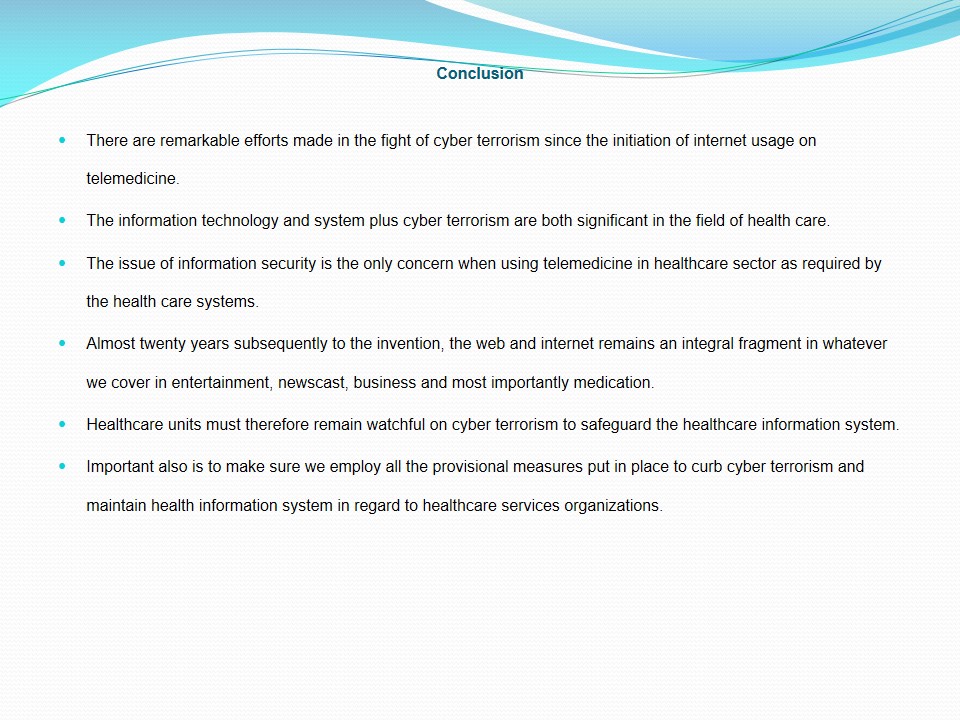
References
Keyes, D. (2005). Medical response to terrorism: Preparedness and clinical practice. Maryland, New York: Lippincott Williams & Wilkins.
Leeuw, K. & Bergstra, J. (2007). The history of information security: A comprehensive handbook. Elsevier Publisher Location.
Shapira, S., Hammond, J., & Cole, L. (1979). Essentials of terror medicine. New York, NY: Springer.
Wolper, L. (2004). Health care administration: Planning, implementing, and managing organized delivery systems. Baltimore, MD: Jones & Bartlett Learning.
Wolper, L. (2010). Health care administration: Managing organized delivery systems. Baltimore, MD: Jones & Bartlett Learning.